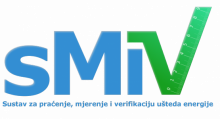
Monitoring, measurement and verification are the “hot topic” of energy efficiency issues, especially when dealing with Energy Efficiency Obligations. However, the process is usually very demanding and requires a lot of resources in terms of time and administration. One possible solution is a systematic approach through customized software for tracking energy efficiency. Croatia has implemented two such central internet solutions in practice, and is now reaping their benefits.
In general, a lot is expected from energy efficiency programs; the European Commission has made over €30 billion available through different financial instruments, funds and project assistance and most of these resources are targeted at the public sector (European Comission, 2015). Energy efficiency is being called “the first fuel” (Energy Efficiency Financial Institutions Group, 2015). It has an immense role in the global CO2 reduction plan, where energy efficiency is supposed to account for 64-84% of all emission reductions from 2020 to 2030 (OECD/IEA, 2009). Nevertheless, banks and companies still often lack trust in crediting energy efficiency programs, which is evident through the existing financial gap for energy efficiency. One of main issues helping this financing setback is inaccurate and inconsistent measurement of delivered energy savings.
Although Croatia is still struggling with many issues under Energy Efficiency Directive, especially Article 7, introducing EEO’s M&V is where Croatia has done its best. There are two national internet platforms for monitoring energy efficiency development: one is ISGE, a dynamic software for measuring actual energy consumption in public buildings; and the other is SMIV, a monitoring platform intended for registering all savings. Although it took some time and human capacities, both systems minimized the administrative burden for energy efficiency activities.
ISGE, or eng. EMIS – Energy management information system was developed under the United Nations Development Programme in Croatia, which undertook first brave steps into a more energy efficient public sector. ISGE was introduced to all public buildings and monitors their energy consumption through energy bills for electricity, heating and water. The system is currently run manually, meaning that each public building has a designated person who enters the bills on monthly basis, but the plan is to set up smart meter (remote) reading in the near future. After the completion of the UNDP project, the Ministry of Construction and Physical Planning took over managing the system and it has since been obligatory for public buildings.
More information on ISGE.
The next developed system was SMIV, or System for monitoring and verification of EE savings. The system was created under a project run by GIZ and has now entered the new Energy Efficiency Act from 2014, making it an obligatory for all parties involved in the National EE Action Plan. The system is a bottom-up measurement tool carrying prescribed formulae on deemed savings calculations. In Croatia bottom-up methodologies have been developed for 20 different energy efficiency measures (building renovation, replacement of housing appliances, boiler replacement, eco-driving, etc.) and are presented in the Rulebook for M&V. The bottom-up monitoring procedure and the methodology were developed in cooperation with many relevant institutions and entail calculations with reference values and baseline calculations specific to Croatia. However, in the case that an end user wants to calculate the achieved energy savings for an energy efficiency measure that is not mentioned in the Rulebook, the new measure has to be proposed to the National EE Authority, which then has to approve the methodology or the new measure. Thus, the system is bottom-up, but it allows for both deemed and measured savings to be entered. SMIV serves not only as a tool for Article 7 of EED, but also for Articles 3 and 5, and since all measures are gathered in one place, it is easier to prevent double-counting.
One of the important issues that is supposed to be solved with SMIV is the verification of measures; since only authorized data, or data signed from authorized experts, can be entered in the system, there is a legal obligation when it comes to verifying EEO’s and energy service contracts through SMIV. The EE Act envisioned a system of disputing savings where any party can dispute savings entered in SMIV, with an equally valid signature from an authorized expert (e.g. a technical designer or a planner), thus eliminating the need of a third party to act as an ombudsman, as mentioned in the EED article 18 (2)c. EED asks member states to “consider putting in place or assigning the role of an independent mechanism, such as an ombudsman, to ensure the efficient handling of complaints and out-of-court settlement of disputes arising from energy service contracts“. In the process described earlier, where both parties which signed the EPC have the right to question the savings, both have the incentive to show proper savings.
Currently the system is ending its first implementation phase and over 6000 measures have already been entered and verified. The data comes from all parties giving out subsidies for energy efficiency, meaning that whichever institution gives out incentives is obligated to enter savings into SMIV. The largest amount of subsidies (and achieved savings) is achieved by the Croatian Eco Fund – Fund for Environment Protection and Energy Efficiency. The organization responsible for the administration and upgrading SMIV is the National EE Authority, part of Centre for Monitoring Business Activities in the Energy Sector and Investments, founded by Ministry of Economy. Thus, creating the system and formulating proper Bottom-Up (BU) methods is only one of necessary steps for the system to run successfully. The other two crucial steps are an optimal combination of sticks and carrots; putting in place legal obligation for system users and administrators, and luring them with state incentives.
It will still take a lot of effort to enter all data into SMIV and educate all obligated parties to properly use it, however it has already made it a lot easier to track EE savings. What remains to be solved are issues of overestimating the savings through deemed versus measured savings, and tackling the infamous issues of ‘additionality’ and ‘materiality’ of entered measures. As it is often said, the system is as smart as the user makes it – however, Croatia can testify that in case such Monitoring and Verification Platform is customized well to a certain country’s needs and demands, it is a very useful way of lowering uncertainties about where, how successfully and at what cost the EE measures are being implemented.
More on SMIV can be found at the National Energy Efficiency Authority.
multEE partner/Source: EIHP


